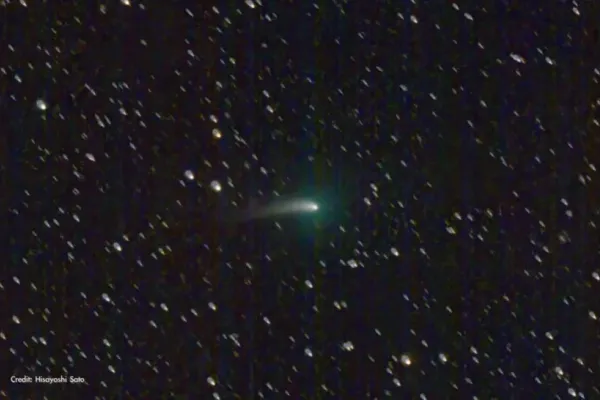Ohio SkyLites - January 2023

What’s Up? Constellations, Planets, and Astronomical Events Visible in January 2023
-Written and Compiled by Alyssa Whalen
Happy New Year! Along with the new year, the days will start to grow longer again since the winter solstice is behind us. This month, the sun will rise near 7:53 am, and set around 5:30 pm; therefore, the average amount of daylight is around 9 hours and 38 minutes, and every day approximately 1 minute and 30 seconds of daylight is added.
The full moon occurs early this month. January’s Wolf Moon will rise on the evening of January 6th. The moon is named by Native Americans for the wolf packs that howl near camps. The new moon will occur on January 21st, so the surrounding days will have the best observing conditions (weather permitting). With luck, some of the faintest objects will be visible on the night of the new moon.
A rare comet is visiting Earth’s sky this month! The comet C/2022 E3 (ZTF) was spotted within Jupiter’s orbit early last year, and it will soon be at its closest approach to Earth on February 2nd. This is a long-period comet believed to originate from the Oort Cloud, and it is estimated that the comet will not return to Earth for at least 50,000 years. It is also a possibility that the comet never returns to Earth, and is ejected from the solar system completely. February 1st and 2nd will be the brightest the comet will be in our sky, but it will still be difficult to view without dark skies or binoculars. The comet will be visible before sunrise between January 20th and February 14th with a telescope and good weather.
The Quadrantids meteor shower occurs this month. This meteor shower runs annually from January 1st through 5th as the Earth passes through the remnants of an extinct comet called 2003 EH1. This year, the shower peaks the early morning of January 4th at an impressive 40 meteors per hour radiating from the constellation Boötes. The constellation will rise on the northeastern horizon near 12:30 am, so the best viewing won’t be until after 1 am. The nearly full moon combined with light pollution will obscure the majority of the meteors this year, but good weather, patience, and a little luck will reward an observer with a good show.
Mercury achieves its greatest western elongation late this month on January 30th. This is when Mercury will be most visible, as this is when the planet is the farthest in front of the sun (from our perspective on Earth); therefore it will be best observed on the eastern horizon before sunrise. However, it will be too close to the sun earlier in the month to be observed.
Venus is visible in the evening this month between sundown and 7 pm. Venus will continue to set later in the evening until it reaches its maximum eastern elongation later in the year. Mars will remain perfectly visible from sundown to nearly sunup, since Mars was in opposition last month. Jupiter rises during the day, so it will be visible at sundown until around 11 pm, and it will continue to set earlier in the evening as the days pass. Saturn is still visible in the early evening, but it sets very soon after sundown around 7:50 pm this month. Soon, Saturn will be too close to the sun to observe, but it will be back in the early morning of April. Uranus and Neptune are currently difficult to see with the naked eye due to their distance from Earth, but Uranus could be viewed with a telescope at the beginning of the night since it sets near 2:30 am.
The constellation Boötes rises late in the night around 1:00 am, and it is commonly identified by the bright star Arcturus. Arcturus can be found by using the most popular guide constellation: Ursa Major (Big Dipper). To find Arcturus, continue the curve of the handle of the big dipper. The imaginary arc will lead straight to Arcturus and the constellation Boötes.
The constellation Canis Major is visible in the southern sky, identified by the brightest star in our sky: Sirius. Canis Major chases Orion across the sky; following Orion’s belt eastward will point directly to Sirius. Between the two is the lesser-known constellation Lepus the rabbit.
Cancer the crab and Leo the Lion are above the eastern horizon at 10:00 pm this month. From there they will run across the sky, reaching directly overhead around 2:00 am, and stay above the horizon until sunrise.
Happy Observing!
Sources:
https://www.timeanddate.com/sun/@5165418?month=1&year=2023
http://www.seasky.org/astronomy/astronomy-calendar-2023.html
https://www.timeanddate.com/astronomy/night/@5165418
https://www.space.com/comet-2022-e3-ztf-possible-naked-eye-visibility-2023
Image Credits:
Full Moon:
https://www.rmg.co.uk/stories/topics/full-moon-calendar
C/2022 E3 (ZTF):
https://www.space.com/comet-2022-e3-ztf-possible-naked-eye-visibility-2023
Image credit: Hisayoshi Sato via NASA/JPL-Caltech
Quadrantids: https://skyandtelescope.org/press-releases/quadrantid-meteors-set-to-perform-on-january-4th/
Elongation Diagram: https://www.skymarvels.com/infopages/vids/2022MercuryGreatestElongations001.htm
Mercury:
Constellations:
